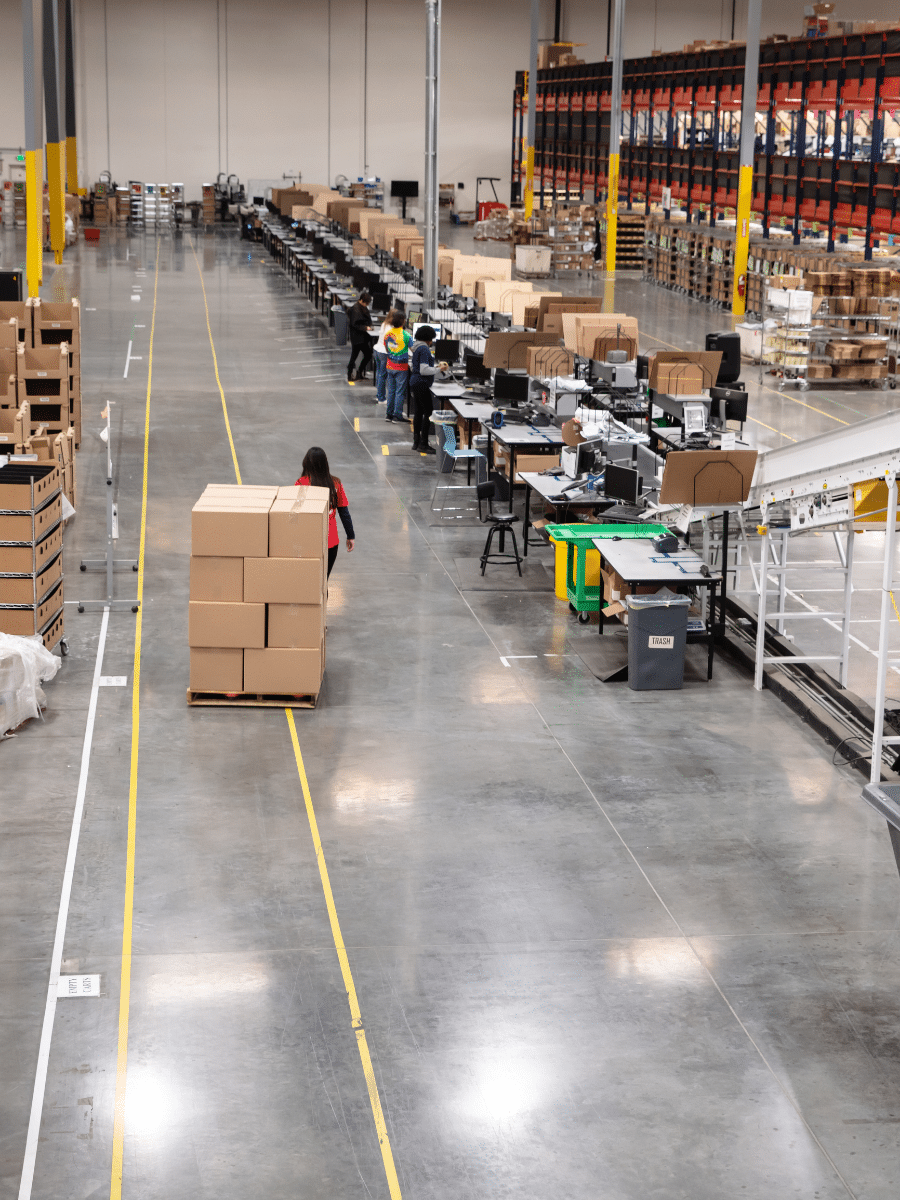Back in the day, the trading floors of Wall Street echoed with the shouts of brokers, much like how traditional warehouses bustled with manual stock checks and paper-based systems. Fast forward to today, trading floors have transformed into digital hubs with algorithms driving decisions, reflecting the seismic shift in warehouses adapting to digital metamorphosis. Just as the stock market world has transcended from analogue to digital, embracing high-speed trades and predictive analytics, the warehousing world stands at a juncture.
The need of the hour? To transition from conventional performance metrics and embrace a strategy that’s geared for the digital age – ensuring that businesses don’t just survive, but thrive!
The journey from the humble beginnings of warehousing, rooted in basic record-keeping, to the dynamic, tech-driven behemoths of today, mirrors the evolution of global industries. Much like the financial markets transitioned from open outcry systems to sophisticated electronic trading, warehouses too have evolved. From chalkboards and clipboards to AI- driven analytics and IoT-enabled tracking, the leap has been monumental.
The strategies warehouses once revered, their trusted Key Performance Indicators (KPIs), now need a digital-age makeover. Just as traders had to relearn and adapt to the age of digital stocks and algorithm-driven decisions, warehouse managers must recalibrate their strategies to optimise for the current era.
Now, as we delve deeper, let’s explore the trajectory of this evolution and the pivotal moments that are redefining warehousing in the digital age.
1. The Bull Market: Classic Metrics and Their Evolution
In the golden age of warehousing, the foundations of performance were built on a set of KPIs. These metrics, much like the blue-chip stocks of old, were considered reliable and consistent. Here’s a detailed exploration of this period and its evolution:
Inventory Accuracy:
This was the bedrock of warehousing metrics. Simply put, it was a measure of how accurately the physical inventory matched the recorded inventory. Just as stockbrokers once jotted down numbers and tallied accounts manually, warehouse managers would rely on physical counts and ledger comparisons.
Order Fill Rate:
This was the gold standard for gauging a warehouse’s efficiency. How many orders could be filled completely from the current inventory? It was akin to evaluating the performance of a stock based on its consistent dividends.
Turnaround Time:
How swiftly could a warehouse process an order? From the time an order was placed to its dispatch, this metric was paramount. In the stock market analogy, think of this as the speed with which a broker could execute a trade when given an order.
Cost Per Order:
A critical financial metric, this was about understanding the operational cost associated with processing each order. Drawing parallels to the financial world, this was similar to calculating the cost of executing a trade, considering broker fees and other related expenses.
The onset of the digital era, marked by technological advancements, began to underscore the inadequacies of conventional measures. While these metrics were apt for warehouses during simpler times, the contemporary warehouse, enriched by various operations, modes, and tech solutions, started to outpace them. The urgency for instantaneous data, forecasting skills, and unified platforms began to eclipse the previously reliable KPIs.
Additionally, with consumer anticipations rising due to e-commerce behemoths offering expedited deliveries, these age-old benchmarks no longer encapsulated the full measure of warehousing effectiveness. It became evident that to address current needs and leverage the potential of new-age tech, warehouses needed to transcend these basic measures. Analogous to how stockbrokers transitioned to digital trading, warehouse overseers recognised the need to incorporate digital evolution into their measurement systems.
2. IPOs & Disruptors: Digital Transformation and Its Revolutionary Impact
With the advent of the digital age, the landscape of warehousing started witnessing disruptions similar to the stock market when innovative start-ups and tech giants began launching their IPOs. These digital innovations weren’t just new tools in the old toolbox; they were revolutionising the very fabric of how warehouses functioned.
Artificial Intelligence (AI) and Machine Learning:
Much like how algorithm-based trading revolutionised the finance sector, the incorporation of AI in warehouses led to enhanced inventory control. Predictive analytics enabled by machine learning allowed warehouses to anticipate demand surges or lulls, optimising stock levels proactively. Moreover, AI-powered robots began to assist, and in some cases replace, manual labour, ensuring faster and error-free processes.
Internet of Things (IoT):
The real-time monitoring capabilities brought on by IoT devices paralleled the tick-by-tick updates of modern trading platforms. Warehouses could now monitor goods throughout their journey within the facility, reducing misplaced items and ensuring seamless transitions from one stage to the next. Temperature-sensitive goods had their conditions continuously monitored, reducing spoilage and waste.
Blockchain:
Just as blockchain promised and delivered a transparent, tamper-proof ledger system in financial transactions, its integration into warehousing ushered in an era of enhanced security and transparency. Supply chains became more trustworthy, with each product’s journey, from manufacturer to end-user, verifiable and immutable.
Augmented Reality (AR):
AR in warehousing can be compared to the advent of sophisticated graphical interfaces in securities trading systems. Warehouse personnel, using AR eyewear, can see the best paths within a facility, identify items more swiftly, and get instant feedback on their assignments, amplifying productivity significantly.
Cloud Computing and Integration:
Much like how varied portfolios became essential in securities trading, a unified system became indispensable for contemporary warehouses. Cloud solutions facilitated the smooth merging of various warehouse components, from stock oversight to order handling, guaranteeing impeccable system interaction. This minimised manual inputs and possible discrepancies, also promoting quicker determinations due to immediate data access.
The digital transformation wave didn’t just stop at introducing advanced tools; it shifted the paradigm from a reactive to a proactive warehousing model. Warehouses were no longer just responding to challenges but were anticipating them. Through data analytics and predictive modelling, they began to foresee trends and adjust strategies in advance, echoing the forward-thinking strategies of modern stock traders.
Fundamentally, the assimilation of these tech solutions redefined the concept of effectiveness and potential in warehouses, prompting leaders and investors to re-evaluate and adjust their performance indicators in accordance with the fresh opportunities and hurdles brought forth by these advancements.
3. Hedging Your Bets: New-Age Metrics and Their Place in Modern Warehousing
In the securities market, savvy investors diversify to protect against uncertainties. Similarly, as the warehousing domain transitioned into the digital epoch, it was essential to adopt modern performance standards to ensure a comprehensive perspective of their operations. These new benchmarks served as safeguards against shortcomings and oversights that classical KPIs might overlook.
Customer Experience Metrics:
In a world driven by online reviews and instant feedback, gauging customer satisfaction became as crucial as monitoring inventory accuracy. It wasn’t just about how fast an item was dispatched, but also how it was received. Were key items delivered on time? Was the packaging intact? Metrics like Net Promoter Score (NPS) started finding their place alongside traditional warehousing KPIs, reflecting the direct-to-consumer nature of many modern warehouses.
Eco-Footprint Tracking:
As environmental consciousness rose, akin to the surge of green investments in financial markets, warehouses felt the pressure to go green. Metrics evaluating energy consumption, waste production, and overall carbon footprint became integral. Warehouses weren’t just measuring efficiency in operations, but also in their responsibility towards the planet.
Real-time Data Accuracy:
The immediate character of digital processes highlighted the significance of up-to-the- minute data precision. Periodic evaluations were no longer adequate. As choices were rendered in mere moments due to data analysis, the precision of instantaneous data became a critical measure.
Integration and Compatibility Metrics:
With various systems and technologies interfacing within modern warehouses, measuring the efficiency of these integrations became essential. How smoothly was data being transferred between AI tools and inventory management systems? Were there delays in processing? These metrics mirrored the importance of integrated portfolios in stock markets, where the synchronisation of multiple assets can impact overall performance.
Risk Management and Cybersecurity:
Just as modern trading platforms prioritise cybersecurity metrics to safeguard investments, digital warehouses started incorporating metrics to gauge the robustness of their cyber- defences. With operations being critically dependent on digital tools, the risk of cyber- attacks became a significant concern, leading to the integration of cybersecurity health checks in performance metrics.
Advanced Forecasting:
Advanced metrics, driven by machine learning, began to offer granular forecasts about demand and supply patterns, peak operational hours, and even predictive maintenance schedules for equipment. This forecasting could be likened to the financial market’s trend analysis, giving warehouse managers a futuristic view, enabling proactive decisions.
The inclusion of these modern measures was more than just adjusting to shifts; it was about achieving a full grasp of every operational angle. While traditional metrics offered a look back, these current KPIs delivered a comprehensive view of the now with foresight into what’s next. Through the utilisation of these measures, warehouses could fortify themselves against unpredicted hurdles, ensuring their continued resilience, nimbleness, and proactive approach.
4. Portfolio Review: The Role of Flexibility in Digital Warehousing
In the financial world, periodic portfolio reviews ensure that investments remain aligned with market dynamics and investor goals. Similarly, in the fast-evolving warehousing landscape, reassessing and adapting performance metrics have become paramount. As strategies diversify and business environments change, the metrics of yesterday might not suffice for tomorrow’s challenges. This section delves into the essence of flexibility in digital warehousing metrics.
Adaptive Integration:
With new digital tools and platforms emerging rapidly, the ability for warehouses to seamlessly integrate these novelties into their existing systems becomes critical. It’s analogous to a portfolio manager’s need to incorporate emerging market sectors or innovative financial instruments. Metrics that measure the ease, speed, and efficiency of such integrations become central to ensuring a warehouse’s adaptability.
Metrics Customisation:
Just as every investor’s goals and risk appetites differ, requiring personalised portfolios, each warehouse might have unique operational nuances. A ‘one-size-fits-all’ approach to performance metrics would be impractical. Modern warehouses require systems that allow for metric customisation, tailoring KPIs to their specific needs, operations, and goals.
Real-time Reassessments:
The volatility of modern markets, be it financial or operational, demands real-time recalibrations. Metrics that can self-adjust based on real-time data, adapting to unforeseen challenges or opportunities, are becoming indispensable. It’s akin to algorithmic trading models that can alter their strategies mid-course based on fresh market data.
Feedback Loop Integration:
The modern warehouse isn’t an isolated entity but is a part of a vast supply chain ecosystem. Incorporating feedback loops from upstream and downstream partners (like suppliers or retailers) and having metrics that gauge the effectiveness of these feedback integrations are crucial. This mirrors the feedback mechanisms in stock trading platforms, where trader feedback can lead to system improvements.
Scalability Metrics:
As enterprises grow or shrink, their storage requirements shift. Assessing the adaptability of a warehouse in adjusting its operations, whether increasing or decreasing, becomes essential. This mirrors financial portfolios that must maintain sufficient liquidity to handle major allocations or disbursements.
Continuous Learning Metrics:
The digital age is characterised by constant evolution. Warehouses that foster a culture of continuous learning and innovation are better positioned for long-term success. Metrics that measure training efficacy, technology adoption rates, and even employee adaptability become pivotal, reflecting the importance of continuous learning in ever-evolving financial markets.
At its core, the emphasis on agility in warehousing indicators highlights the need to remain pertinent, malleable, and visionary. Just as financial portfolios are regularly reviewed to align with market fluctuations, warehousing benchmarks should continually adapt, ensuring they mirror the operational present and aspirations for the coming times.
Steering through the digital era’s warehousing terrain is comparable to navigating the ebbs and flows of the stock market. It demands instinct, evidence-based tactics, flexibility, and the acumen to anticipate upcoming trends. By modernising our benchmarks and syncing them with the digital age, we not only enhance our immediate operations but also lay groundwork for a future rich in prospective gains.
Always bear in mind, in the warehousing realm, adaptability is the key to flourishing!



